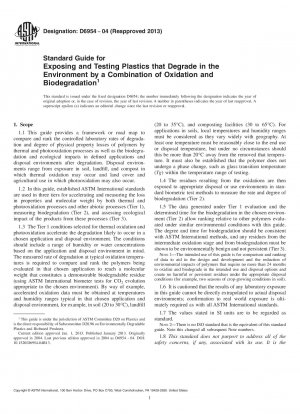ASTM D6954-04(2013)
Standard Guide for Exposing and Testing Plastics that Degrade in the Environment by a Combination of Oxidation and Biodegradation
- Standard No.
- ASTM D6954-04(2013)
- Release Date
- 2004
- Published By
- American Society for Testing and Materials (ASTM)
- Status
- Replace By
- ASTM D6954-18
- Latest
- ASTM D6954-24
- Scope
5.1 This guide is a sequential assembly of extant but unconnected standard tests and practices for the oxidation and biodegradation of plastics, which will permit the comparison and ranking of the overall rate of environmental degradation of plastics that require thermal or photooxidation to initiate degradation. Each degradation stage is independently evaluated to allow a combined evaluation of a polymer???s environmental performance under a controlled laboratory setting. This enables a laboratory assessment of its disposal performance in, soil, compost, landfill, and water and for use in agricultural products such as mulch film without detriment to that particular environment.
Note 5???For determining biodegradation rates under composting conditions, Specification D6400 is to be used, including test methods and conditions as specified.5.2 The correlation of results from this guide to actual disposal environments (for example, agricultural mulch films, composting, or landfill applications) has not been determined, and as such, the results should be used only for comparative and ranking purposes.
5.3 The results of laboratory exposure cannot be directly extrapolated to estimate absolute rate of deterioration by the environment because the acceleration factor is material dependent and can be significantly different for each material and for different formulations of the same material. However, exposure of a similar material of known outdoor performance, a control, at the same time as the test specimens allows comparison of the durability relative to that of the control under the test conditions.
1.1 This guide provides a framework or road map to compare and rank the controlled laboratory rates of degradation and degree of physical property losses of polymers by thermal and photooxidation processes as well as the biodegradation and ecological impacts in defined applications and disposal environments after degradation. Disposal environments range from exposure in soil, landfill, and compost in which thermal oxidation may occur and land cover and agricultural use in which photooxidation may also occur.
1.2 In this guide, established ASTM International standards are used in three tiers for accelerating and measuring the loss in properties and molecular weight by both thermal and photooxidation processes and other abiotic processes (Tier 1), measuring biodegradation (Tier 2), and assessing ecological impact of the products from these processes (Tier 3).
1.3 The Tier 1 conditions selected for thermal oxidation and photooxidation accelerate the degradation likely to occur in a chosen application and disposal environment. The conditions should include a range of humidity or water concentrations based on the application and disposal environment in mind. The measured rate of degradation at typical oxidation temperatures is required to compare and rank the polymers being evaluated in that chosen application to reach a molecular weight that constitutes a demonstrable biodegradable residue (using ASTM International biometer tests for CO2 evolution appropriate to the chosen environment). By way of example, accelerated oxidation data must be obtained at temperatures and humidity ranges ty......
ASTM D6954-04(2013) Referenced Document
- ASTM D3826 Standard Practice for Determining Degradation End Point in Degradable Polyethylene and Polypropylene Using a Tensile Test
- ASTM D3987 Standard Test Method for Shake Extraction of Solid Waste with Water
- ASTM D5071 Standard Practice for Exposure of Photodegradable Plastics in a Xenon Arc Apparatus
- ASTM D5208 Standard Practice for Fluorescent Ultraviolet (UV) Exposure of Photodegradable Plastics
- ASTM D5272 Standard Practice for Outdoor Exposure Testing of Photodegradable Plastics
- ASTM D5338 Standard Test Method for Determining Aerobic Biodegradation of Plastic Materials Under Controlled Composting Conditions
- ASTM D5510 Standard Practice for Heat Aging of Oxidatively Degradable Plastics
- ASTM D5526 Standard Test Method for Determining Anaerobic Biodegradation of Plastic Materials Under Accelerated Landfill Conditions
- ASTM D5951 Standard Practice for Preparing Residual Solids Obtained After Biodegradability Standard Methods for Plastics in Solid Waste for Toxicity and Compost Quality Testing
- ASTM D5988 Standard Test Method for Determining Aerobic Biodegradation in Soil of Plastic Materials or Residual Plastic Materials After Composting
- ASTM D6002 Standard Guide for Assessing the Compostability of Environmentally Degradable Plastics
- ASTM D6400 Standard Specification for Compostable Plastics
- ASTM D883 Standard Terminology Relating to Plastics
- ASTM E1440 Standard Guide for Acute Toxicity Test with the Rotifer Brachionus
ASTM D6954-04(2013) history
- 2024 ASTM D6954-24 Standard Guide for Exposing and Testing Plastics that Degrade in the Environment by a Combination of Oxidation and Biodegradation
- 2018 ASTM D6954-18 Standard Guide for Exposing and Testing Plastics that Degrade in the Environment by a Combination of Oxidation and Biodegradation
- 2004 ASTM D6954-04(2013) Standard Guide for Exposing and Testing Plastics that Degrade in the Environment by a Combination of Oxidation and Biodegradation
- 2004 ASTM D6954-04 Standard Guide for Exposing and Testing Plastics that Degrade in the Environment by a Combination of Oxidation and Biodegradation

Copyright ©2024 All Rights Reserved